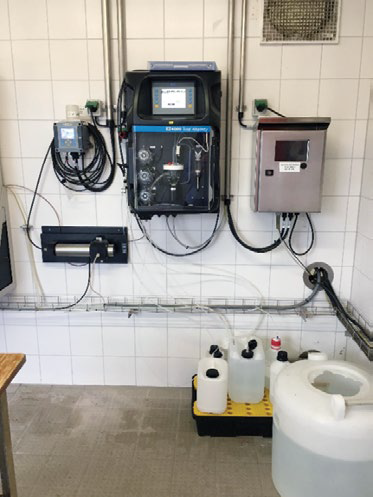應用實績:德國布萊斯高灣污水處理廠透過連續監測水中鹼度以優化碳酸鈣的投放劑量
Breisgau Bay wastewater association: Optimization of CaCO₃ dosing with continuous alkalinity measurement
Introduction 介紹
Due to the catchment area and the diverse and large number of indirect dischargers, the sewage treatment plant‘s influent has a high nitrogen content. The annual average for the total nitrogen concentration here is 55 mg/L. Nevertheless, strict limits are imposed on the plant, as it discharges into an ecologically sensitive body of water. The annual values achieved by the treatment plant can be found in Tab. 1. Due to the very soft water, as well as heavy rainfall events in the catchment area of the wastewater treatment plant, monitoring of the acid capacity parameter was an essential component in optimizing nitrification.
Due to the catchment area and the diverse and large number of indirect dischargers, the sewage treatment plant‘s influent has a high nitrogen content. The annual average for the total nitrogen concentration here is 55 mg/L. Nevertheless, strict limits are imposed on the plant, as it discharges into an ecologically sensitive body of water. The annual values achieved by the treatment plant can be found in Tab. 1. Due to the very soft water, as well as heavy rainfall events in the catchment area of the wastewater treatment plant, monitoring of the acid capacity parameter was an essential component in optimizing nitrification.
德國布萊斯高灣污水處理廠的集水區面積大且進水源種類繁多,此污水處理廠的進水氮濃度高。年平均總氮濃度為55 mg/L。污水處理廠的污水在經過處理後會排放到生態敏感的水體中,因此其排放標準受到嚴格的限制。此污水處理廠的年排放值如表1。由於此污水處理廠集水區水質極軟,且降雨量較大,因此監測酸度容量參數是優化硝化過程的關鍵。
The wastewater here does not have a sufficiently high acid capacity, which can lead to a drop in the pH value below 7.0, as the nitrifying bacteria produced acid. In this pH range, however, both the nitrification and oxygen utilization rates and flocculation are impaired. The high amounts of acidic precipitant added to maintain the very low Ptotal limit in the wastewater treatment plant effluent also have a negative influence on the acid capacity. The following application report discusses the tests carried out on-site to define a strategy for dosing CaCO3 based on an acid capacity measurement.
其污水的酸度容量不夠高,硝化細菌產生酸,導致pH值降至7.0以下。而在此pH範圍內,硝化、氧氣利用率以及絮凝效果都會受到影響。同時,為保持污水處理廠排放水非常低的總磷限值而投放的大量酸性沉澱劑也對酸度容量產生負面影響。以下應用討論現場進行的測量,並根據酸度容量的監測數據以確定 CaCO3碳酸鈣投放藥劑量的操作策略。
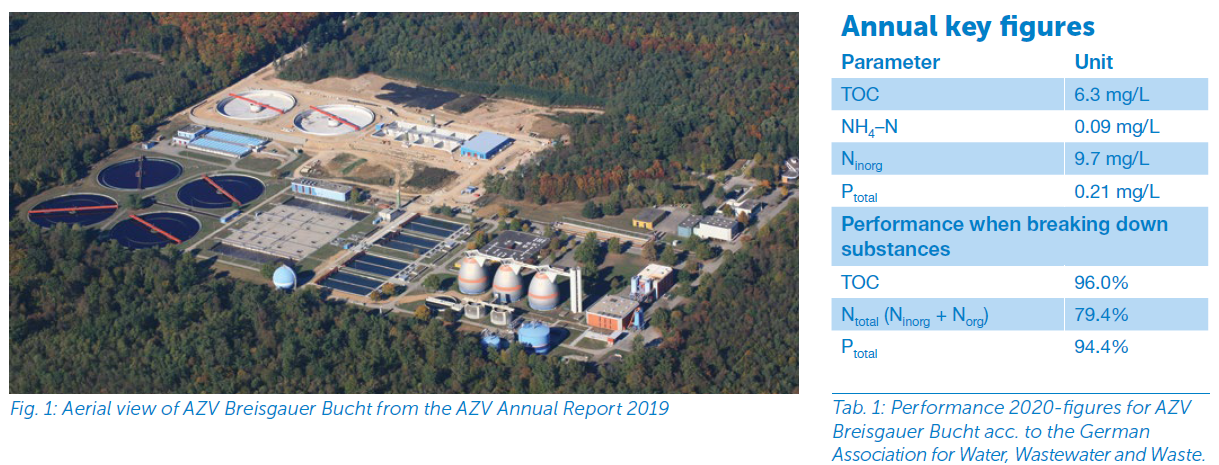
Acid capacity as a measure of buffer capacity 酸度容量作為緩衝容量的衡量指標
The acid capacity is a measure of the buffer capacity, i.e. the pH value stability of the water compared to acids introduced or formed in the water. The acid formation associated with nitrification in the activation tank (release of H+ions, see equation 1) leads to a reduction in the pH value. The decomposition of 1 mg NH₄-N consumes 0.14 mmol of acid capacity.
The acid capacity is a measure of the buffer capacity, i.e. the pH value stability of the water compared to acids introduced or formed in the water. The acid formation associated with nitrification in the activation tank (release of H+ions, see equation 1) leads to a reduction in the pH value. The decomposition of 1 mg NH₄-N consumes 0.14 mmol of acid capacity.
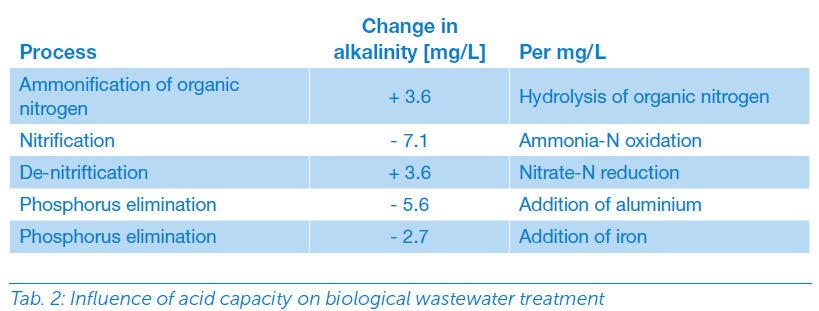
Background 背景介紹
Very soft water as well as heavy rainfall events occurring as a result of elevated topography in the plant’s catchment area lead to a low acid capacity of the influent. Limit-related dosing of large amounts of acid precipitant, as well as a low availability of carbon for de-nitrification, further impair the acid capacity.
Very soft water as well as heavy rainfall events occurring as a result of elevated topography in the plant’s catchment area lead to a low acid capacity of the influent. Limit-related dosing of large amounts of acid precipitant, as well as a low availability of carbon for de-nitrification, further impair the acid capacity.
由於布萊斯高灣污水處理廠的集水區地勢較高,水質極軟且降雨量大,導致進水酸度容量較低。酸性沉澱劑的投放劑量受限,以及脫硝碳的可用性較低,進一步降低進水的酸度容量。
Solution 解決方案
A Hach® EZ4000 series titrimetric online alkalinity analyzer was installed first in the primary sedimentation effluent after pre-precipitation and then in the activated sludge stage effluent. The tests have shown that the measurement of alkalinity in the activated sludge effluent, taking into account the influent volume, is ideal as a control variable for the CaCO3 dosage.
在預沉澱後的初級沉澱排放水處安裝一台Hach EZ4000系列滴定法的線上鹼度自動分析儀,然後在活性污泥階段的排放水處也安裝一台EZ4000線上鹼度自動分析儀。試驗顯示,將進水量納入考慮,監測活性污泥排放水的鹼度是控制碳酸鈣投放量的理想選擇。
Fig. 2: EZ4004 online titrator from Hach
Benefits 優勢
Implementing the alkalinity analyzer and dosing of Omya Optical based on the alkalinity deficit makes wastewater treatment plant operations less vulnerable to the fluctuating hydraulic loads and allows for a more targeted CaCO3 consumption with savings of up to 30%.
採用水中鹼度自動分析儀加上Omya Optical 投放藥劑,降低污水處理廠運作對水力負荷波動的影響,並節省了高達30%碳酸鈣藥劑的消耗量。
Establishing a dosing strategy 制定藥劑投放策略
For 10 years now, AZV Breisgauer Bucht has been using various CaCO3 products (also OMYA Optical) to control the alkalinity concentrations in the biological stage. For the operator, simple and safe handling as well as uncritical behavior in the event of a possible overdose of CaCO3 are essential characteristics of such products. The product is dosed in powder form into the activation influent, after pre-precipitation. Until now, the control variable was the pH value in the activation influent and effluent.
For 10 years now, AZV Breisgauer Bucht has been using various CaCO3 products (also OMYA Optical) to control the alkalinity concentrations in the biological stage. For the operator, simple and safe handling as well as uncritical behavior in the event of a possible overdose of CaCO3 are essential characteristics of such products. The product is dosed in powder form into the activation influent, after pre-precipitation. Until now, the control variable was the pH value in the activation influent and effluent.
The pH value is determined by the concentration of the H+ ions in the water. If a hydraulic thrust is expected, the aeration is ramped up at an early stage. This leads to increased CO2 stripping and suggests an increase in the pH value. If this process is controlled via the pH value, this leads to a reduction of the dosing quantity, even though this should be increased at this moment. To avoid this effect, the alkalinity – which is the more independent parameter – should be used as the control variable.
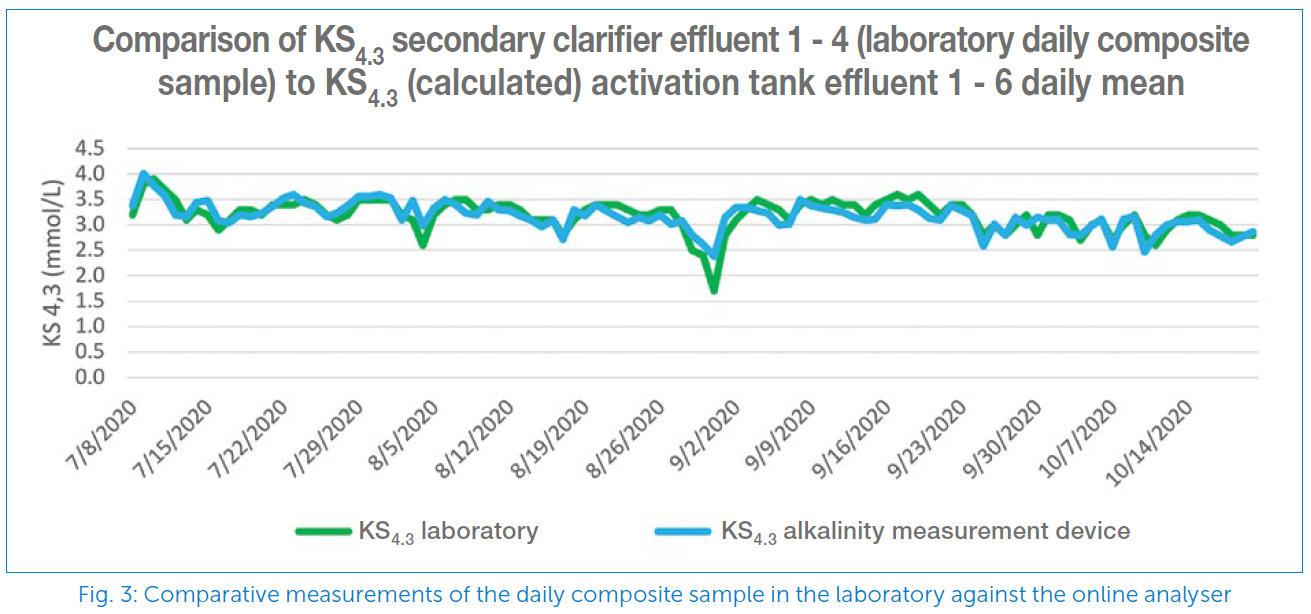
Summary
At AZV Breisgauer Bucht, a number of factors come together that have a negative impact on acid capacity. On the one hand, there is the very soft water with a hardness < 10 dH. On the other hand, there is a rather poor C/N ratio, which has a negative effect on denitrification, which in turn has a negative effect on the acid capacity. Large volumes of mixed water and hydraulic shocks load the system with a lot of rainwater and low acid capacity. Due to very low Ptotal values in the effluent, large quantities of acid precipitants have to be added. The only structurally possible doing point for the calcium carbonate is the return activated sludge pump station. Dosing directly into the nitrification is not possible.
At AZV Breisgauer Bucht, a number of factors come together that have a negative impact on acid capacity. On the one hand, there is the very soft water with a hardness < 10 dH. On the other hand, there is a rather poor C/N ratio, which has a negative effect on denitrification, which in turn has a negative effect on the acid capacity. Large volumes of mixed water and hydraulic shocks load the system with a lot of rainwater and low acid capacity. Due to very low Ptotal values in the effluent, large quantities of acid precipitants have to be added. The only structurally possible doing point for the calcium carbonate is the return activated sludge pump station. Dosing directly into the nitrification is not possible.
有許多因素會對布萊斯高灣污水處理廠的酸度容量產生負面影響。一方面,水質非常軟,硬度低於 10 dH。另一方面,碳氮比 (C/N) 較低,這會對反硝化過程產生負面影響,進而影響酸度容量。大量的混合水質和水力衝擊讓集水系統承受大量雨水,酸度容量較低。由於排水處的總磷值非常低,因此必須添加大量的酸性沉澱劑。
Despite this initial situation, two goals were defined at the beginning. On the one hand, the Ca/Na ratio should be raised to greater than 0.6, which leads to more stable flakes in the activation. This also improves the settling capacity of the activated sludge. In addition, the risk of filamentous organisms forming is reduced. On the other hand, the acid capacity should be adjusted to around 2.5 mmol/L. This corresponds to around 125 mg/L of CaCO3. Due to the aforementioned negative influencing factors, the DWA‘s recommendation was increased.
Fig. 4 shows an excerpt from the PLC of AZV Breisgauer Bucht. The wastewater treatment plant influent can be seen in purple, the addition of the carbonates in light blue and the measured value of the alkalinity analyzer in green. A correlation between rainfall events and a decrease in alkalinity is very clearly recognizable. Despite maximum carbonate dosing, the alkalinity first drops to < 2.0 mmol/L of CaCO3. The reason for this is the hydraulic residence time between the measuring and dosing point and the limited performance of the dosing screw. However, this turned out to be uncritical during operation.
圖4 顯示布萊斯高灣污水處理廠的PLC摘錄。紫色表示污水處理廠的進水,淺藍色表示投放的碳酸鹽劑量,綠色表示鹼度自動分析儀的監測數值。降雨事件與鹼度下降之間的相關性非常明顯。儘管碳酸鹽投放量達到最大值,鹼度仍會先下降至<2.0 mmol/L的CaCO3。造成這種情況的原因是監測點和加藥點之間的水力停留時間以及投加螺桿的有限效能。然而實證顯示其在運作過程並不是關鍵。
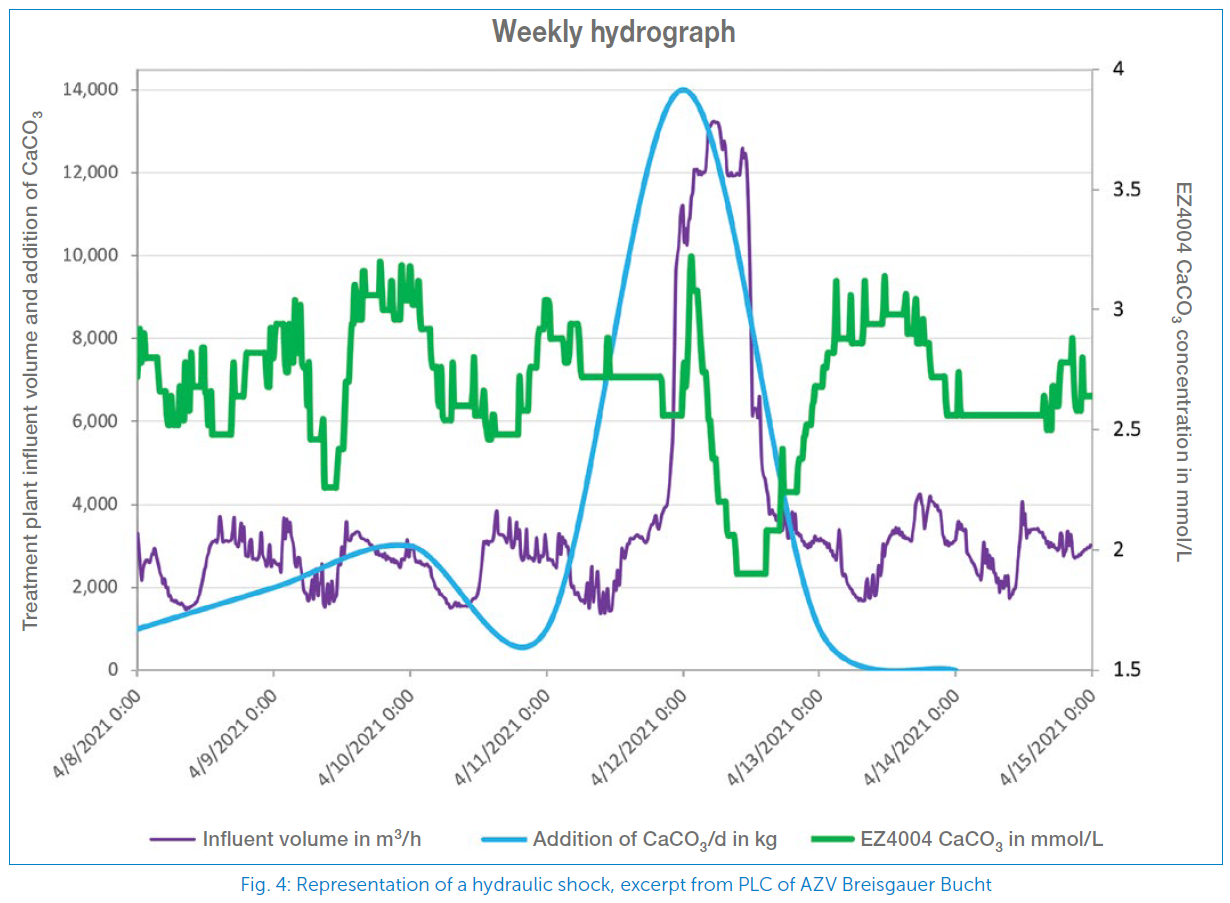
In conclusion, it can be said that by measuring the alkalinity concentration in the biological stage effluent, regulation of the acid capacity, taking into account the wastewater volume, can be implemented very well and very precisely. During heavy rainfall events, short-term downward outliers do occur, but on average the acid capacity could be set relatively stable at 2.9 mmol/L. Furthermore, regulation of the acid capacity via continuous alkalinity measurement enabled great savings to be achieved, which quickly recovers purchase costs.
總結,透過監測生物階段排放水的鹼度濃度,可以非常精準地調節酸度容量,並根據廢污水量進行調整。在強降雨期間,確實會出現短期內下降的異常值,但平均而言,酸度容量可以相對穩定地設定在 2.9 mmol/L。此外,透過連續監測鹼度來調節酸度容量可大幅節省藥劑成本。
Source :

